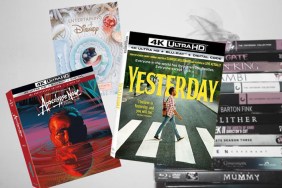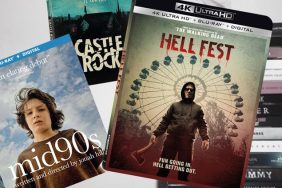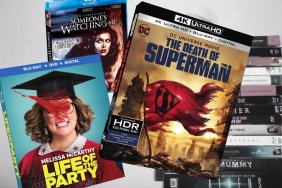Doon Arbus, Diane Arbus’ daughter, kicks off this 1972 documentary on her mother and her mother’s work by sharing childhood memories of how the appeared and existed in their home, and keen analysis of what photography did for and meant to her mother – not only as an artist, but as a human being. It’s a smooth toggling back and forth between personal anecdotes and professional contextualizing. In her voice you hear pride and thoughtfulness, but never sentimentality. (She refers to her mother as Diane, not “mom” or “mother.”) After that set-up, we’re dropped into a stream of Arbus’ work, with her recorded voice explaining her process and what she’s ultimately after with her camera.

Child With Hand Grenade, Copyright Diane Arbus Estate
Arbus remains a controversial figure. Were her photos an exploitative wallowing in misery and freakishness for shock value? In the four decades since her death, her stark, compelling images of the flipside of cultural “norms” and ideals have amassed more fans than detractors (Susan Sontag wrote of Arbus’ work that it is “based on distance, on privilege, on a feeling that what the viewer is asked to look at is really other”), but there are still those who view her aesthetic and approach with a suspicious eye. And there are even more who grapple with the work without being either fanboy or reflexively dismissive, who try to parse what it means for a woman born into great privilege but who feels like an outsider to identify with society’s freaks and outcasts.
At one point in the film, Arbus’s recorded voice says, “They [freaks] made me feel a mixture of shame and awe. There’s a quality of legend about freaks – like a person in a fairytale who stops you and demands that you answer a riddle. I mean, if you’ve ever spoken to someone with two heads, you know they know something you don’t. Most people go through life dreading they’ll have a traumatic experience. Freaks were born with their trauma. They’ve already passed their test in life. They’re aristocrats.” You can imagine someone rolling their eyes at the soft fetishizing taking place in the photographer’s words, but there’s also genuine affection and thought there – and a kind of truth as well.

Puerto Rican Woman With Beauty Mark, Copyright Diane Arbus Estate
Subject matter and aesthetics once considered shocking or unnerving are now – largely because of Arbus’ unconventional interests and dogged documentation of them, the way she funneled them into mainstream discourse through her work – the stuff of fashion layouts, music videos, and indie films straining for outsider chic credibility. Everyone from Nan Goldin to Cindy Sherman is at least somewhat influenced by her.
On the recording of her that plays over her work (a recording made by a former student), Arbus says, “If I were just curious, it would be very hard to say to someone I want to come to your house and have you talk to me and tell me the story of your life… people are going to say you’re crazy, plus they’re going to keep mighty guarded. But the camera is a kind of license, and for a lot of people they want to be paid that kind of attention. And that’s a reasonable attention to pay.” The film cuts back and forth between passages where Arbus’ images flow across the stream as she talks about her childhood, why she does what he does, how she gains the trust of her subjects, and talking heads giving their analysis of her art.

Diane Arbus, Love-in Central Park. Photo by Garry Winogrand
Photographer Lisette Model contextualizes Arbus’ talent as fitting in the age-old model of the artist who is so new, who is doing something so unprecedented, that they are met with hostility and confusion because we don’t yet have the tools or language to process what they’re doing. In her own voice, the photographer weighs in on how she wins the trust of her subjects (“I think I’m kind of two-faced. I’m really ingratiating. It really kind of annoys me. I’m just sort of a little too nice.”), and of the jumble of motivations and emotions that flow through her when she’s in the throes of her creative pursuits. Digging into the role of artist as philosopher, she speaks on the gaps between who we want to be, what we might think we are, and who we really are, the gap between intention and effect, and there’s an unexpected joy in her voice even as she sometimes stumbles through her explanations. (It’s actually a pleasure to hear an artist speak on their work without sounding like a CEO pitching product.)

There’s an oddly soothing quality to the documentary, its tone and rhythm, which is interesting given the discomfiting quality of so much of Arbus’ work. But the early ‘70s fashions, the fact that images don’t whiz by in jagged quick-edit rhythms that are now the norm, the absence of music to tell how to feel, and the openness of Arbus when speaking, all gently pull the viewer into a fascinating critical overview. At one point, Arbus seems to sum up her practice and how it fits into the culture.“Something is ironic in the world,” she says, “and it has to do with the fact that what you intend never comes out like you intended. What I’m trying to describe is that it’s impossible to get out of your skin into somebody else’s, and that’s what all this is a little bit about – that somebody else’s tragedy is not the same as your own.”
Top Photo: Roz Kelly / Getty Images
Previously on Art Doc of the Week:
Art Doc of the Week
-
Art Doc of the Week | Los Punks: We Are All We Have

The award-winning doc looks at Los Angeles’ 40-year-old punk scene.
Photo: Angela Boatwright
-
Art Doc of the Week | McQueen and I

The late fashion designer Alexander McQueen’s life was as unconventional as his iconic shows.
Photo: Alexander McQueen: Savage Beauty
-
Art Doc of the Week | Who Is Poly Styrene?

The late British-Somali punk icon was vulnerable in her feminist art.
Image Courtesy the Artist Estate
-
Art Doc of the Week | Eva Hesse

The new documentary on the on the late visual artist is both informative and soulful.
Image Courtesy the Filmmaker
-
Art Doc of the Week | Packed in a Trunk

Edith Lake Wilkinson’s great niece investigates why the painter was institutionalized for seemingly no reason.
Photo: Wolfe Video
-
Art Doc of the Week | The Kate Bush Story

The 2014 BBC documentary on the reclusive pop star lets her high-profile fans swoon all over her.
Photo: Peter Mazel / Sunshine
-
Art Doc of the Week | Nikki Giovanni and Muhammad Ali in Conversation

The ionic poet interviews and is charmed by the sports legend for Soul talk show.
Photo: Getty Images
-
Art Doc of the Week | They Will Have to Kill Us First

Malian musicians use their music to stand up to Islamic fundamentalists.
Photo: BBC Worldwide
-
Art Doc of the Week | Step Up and Be Vocal

The 2001 film looks at the role punk played and plays in shaping some queer and feminist identities.
Photo: PansyDivision.com
-
Art Doc of the Week | Mapplethorpe: Look at the Pictures

The first ever documentary on Robert Mapplethorpe makes the case for his art and legacy while showing his warts and all.
Photo: J. Paul Getty Trust / LACMA / Robert Mapplethorpe Foundation
-
Art Doc of the Week | Parliament Funkadelic: One Nation Under A Groove

Director Yvonne Smith traces funk from its doo-wop origins to its role as a building-block of hip-hop.
Photo: GeorgeClinton.com
-
Art Doc of the Week | Pete Seeger: The Power of Song

An OG political protest singer has much to teach us today.
Photo: Reuters
-
Art Doc of the Week | The Post Impressionists: Munch

Edvard Munch was a poster boy for the idea of the artist as brilliant, immeasurably tortured soul.
-
Art Doc of the Week | Detroit, Vogue

Director Mollie Mills’s short doc on Detroit’s current ball culture is high on visual impact, skimpy on substance.
Photo: Vogue, Detroit
-
Art Doc of the Week | Colored Frames
 The paintings highlighted in Lerone D. Wilson’s film are pulled into deep conversation with the complex realities of black life.
The paintings highlighted in Lerone D. Wilson’s film are pulled into deep conversation with the complex realities of black life.Photo: Colored Frames
-
Art Doc of the Week | Spirits of Rebellion

Filmmaker Zeinabu Irene Davis’ documentary on filmmakers of the LA Rebellion is timely and illuminating.
Photo: Spirits of Rebellion / Julie Dash
-
Art Doc of the Week | Five

The 1971 documentary gives an overview of five African American visual artists as the bloody ‘60s turn into the hopeful ‘70s.
Photo: 110 St Harlem Blues, by Romare Bearden, courtesy DC Moore Gallery
-
Art Doc of the Week | Masters of Photography: Diane Arbus

This 1972 documentary filmed one year after the photographer’s suicide is intimate and revealing.
Top Photo: Roz Kelly / Getty Images
-
Art Doc of the Week | Dorothea Lange: An American Odyssey

The iconic photographer’s images of 20th century Depression-era America speak to current battles around class, race, immigration, and poverty.
Photo: Dorothea Lange
-
Art Doc of the Week | Out and Bad: London’s LGBT Dancehall Scene

The struggles and joys of forging queer identity within dancehall culture.
Photo: Dazed/Bernard Miller
-
Art Doc of the Week | And When I Die, I Won't Stay Dead

Director Billy Woodberry’s poetic take on the life and work of beat poet Bob Kaufman.
Photo: Billy Woodberry
-
Art Doc of the Week | The Sound of Redemption

Director N.C. Heikin turns saxophonist Frank Morgan’s life into one of 2015’s best documentaries.
-
Art Doc of the Week | It Came from Kuchar

The Bronx-raised Kuchar twins helped pioneer American underground film.
Photo: Indie Pix
-
Art Doc of the Week | Tamara de Lempicka

The visionary artist, an OG Material Girl, is still struggling to get art world respect.
Photo: http://www.delempicka.org/
-
Art Doc of the Week | Jaco

A documentary on the life and music of Jaco Pastorius also probes link between mental illness and creativity.
Photo: JacoPastorius.com
-
Art Doc of the Week | Janis Joplin: Little Girl Blue

A new documentary on the late rock icon digs beneath the lore to find a complex woman and artist.
Photo: Evening Standard/Getty Images
-
Art Doc of the Week | The Many Faces of Billie Holiday

Lady Day was much more than her blues, as this documentary makes clear.
Photo: The William P. Gottlieb Collection
-
Art Doc of the Week | Anita Sarko

The legendary DJ’s words on art, culture and creativity resonate powerfully in the wake of her recent death.
Photo: Svetlana Samoshina
-
Art Doc of the Week | Antonio Gaudi

Filmmaker Hiroshi Teshigahara lets out his inner fanboy as he pays tribute to his hero, iconic architect Antonio Gaudi.
Photo: The Criterion Collection
-
Art Doc of the Week | Poetry of Resilience

Katja Esson's documentary allows poets to reclaim the depth and possibilities of art.
Photo: Jeremy Sutton Hibbert





